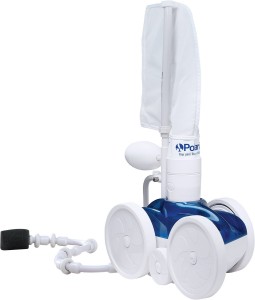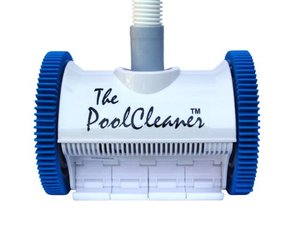How to Use a Pool Vacuum
While above ground pools are often less maintenance, they still require some care in order to keep it sparkling clean. While a pool cover will definitely help to keep out debris, you are eventually going to need a pool vacuum to keep it from growing algae on the pool walls and floor. If your pool water is cloudy, this is a sure sign it is in need of a cleaning and you should probably not be swimming in it. You should also always vacuum your pool immediately before you shock your pool to remove any large debris first.
Pool vacuums can range anywhere from under $100 up to $3,000. Additionally, they have manual and automatic pool vacuums available. One of the most common reasons people let their pool go is that they are not educated on how to vacuum a pool properly. Trying to figure out the filter and the skimmer and the vacuum can be intimidating and sound like a lot of work. The truth is if you know how to do it, it can be a very simple process. Keeping up with your pool is actually not that hard at all. You just have to take the time to learn how to do it properly and then make sure it is part of your routine chores. In this article, we will talk about how to vacuum a pool, whether manual or automatic.
How to Use a Manual Pool Vacuum
Every manual pool vacuum should consist of a vacuum head, a hose and a pole. The first thing you want to do is hook up the long pole to your vacuum head. The pole will allow you to move the vacuum around the bottom of your pool with ease to collect the debris.
Next, you will need to connect one end of the hose to the vacuum head itself. This should be fairly obvious where to connect on any pool vacuum. One side of the hose will likely have a swivel head and this is the side that will attach to the head.
The vacuum head can then be lowered to the bottom of the pool along with the hose. Make sure to keep the other end of the hose in your hand. You can then place the other end of the hose in front of the water intake (where water enters the pool) so that you fill your hose entirely with water. If you see bubbles, that is a good sign! Once the water is flowing into the hose with no air bubbles, it will sink beneath the surface.
You should now have now created suction. If you do not have suction, then you likely still have air in your hose. You can then connect the hose to the skimmer that should be mounted to the side of your pool via the vacuum adapter plate. Your vacuum is now ready for use!
By using the long pole connected to your vacuum head, you can glide the head along the bottom, sides and steps of your pool and begin collecting debris. It is best to avoid any large leaves or other debris until you are almost finished so that you don’t clog the vacuum. Clean up any and all of the sand from the bottom and then pick up anything else. Obviously, large debris that can easily be picked out of the pool with a net should be done first so as not to clog or harm your pool vacuum. Once your pool is clean, you can then disconnect the hose from the filter.
How to Use an Automatic Pool Vacuum
There are three main types of automatic pool vacuums that vary in price and how they work.
Robotic Pool Vacuum
Check Price NowRobotic pool vacuum cleaners, such as the Dolphin Nautilus pool cleaner (picture above), are self-contained systems that clean the pool solely on their own with no human interaction required. They do a fantastic job at picking up any debris, whether it be small grains of sand or large leaves. This system propels itself across the bottom, sides and steps of your pool cleaning and scrubbing while it goes. While these are the most expensive of the pool vacuums, these are also the most efficient and will likely save you money in the long run.
Pressure-side Pool Vacuum
Check Price NowThe pressure-side automatic pool vacuuming systems are best for pools that tend to collect large debris. This system is powered by the water pressure as it skims the surface and sucks the debris into a separate bag rather than the filter. Because it focuses on the larger debris, it sometimes missed the dirt which is then collected into the filter. These can be purchased with or without a booster pump so the price can vary greatly. Since these are powered by water pressure, a booster pump is usually recommended in order to operate effectively. Even with a booster pump, they are usually less expensive than the robotic vacuums.
Suction-side Pool Vacuum
Check Price NowSuction-side vacuum systems are often the least expensive of the automatic pool vacuuming systems. This system takes advantage of your existing pump and filtration system. The suction from the pump enables your vacuum to move around the pool collecting debris. However, if your existing pump and filtration system is weak, the vacuum will not be very efficient. And because you are pulling debris into your filter system, you will be required to change your filter more frequently. That being said, you can adjust your pool pump to accommodate the vacuum in order to make it more efficient. One of the most popular suction-side vacuums is the Zodiac Baracuda G3 Pool Cleaner.
Manual Pool Vacuum vs. Automatic Pool Vacuum
The big question is often this: should I go with an automatic pool cleaner, like the Pentair Kreepy Krauly, or a manual pool vacuum cleaner system? Unfortunately, I cannot answer that for you as it really is a matter of opinion and budget. A manual system is going to be the least costly of your options. It will require more work from you, but you will likely do a better job than any automatic vacuum, especially around your above ground pool steps or ladder which is difficult to reach for most automatic pool vacuums. It also means your pool will likely not need to be cleaned as often. On the other hand, if you prefer to actually be able to enjoy your pool rather than clean it and if your budget allows for it, then automatic cleaner might be the best bet for you. Once you set it up, it does all of the work for you.



